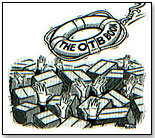| O.T.B. and P.O.S. are not mutually exclusive: They work well as a team and provide even better information when used together. |
Mort Haaz, president of O.T.B. Retail Systems in Santa Monica, Calif., shares his views on inventory tracking systems in the article that follows.
Retailers in the rapidly changing toy industry need to know how much of what products to stock at any given time to stay profitable. Thankfully, there is software available to help: point of sale (P.O.S.) and open to buy (O.T.B.). But which to choose?
 P.O.S. systems are basically computerized cash registers. They track each SKU (stock keeping unit) of each item of merchandise. When orders are placed, those orders are entered into the P.O.S. When merchandise is received and then sold, that information goes into the P.O.S. by keying or scanning. With this information, a variety of management reports can be derived to aid retailers in merchandising and accounting. Since it is basically tracking and accounting, other bonuses can be built in, such as customer tracking, label printing, etc.
P.O.S. systems are basically computerized cash registers. They track each SKU (stock keeping unit) of each item of merchandise. When orders are placed, those orders are entered into the P.O.S. When merchandise is received and then sold, that information goes into the P.O.S. by keying or scanning. With this information, a variety of management reports can be derived to aid retailers in merchandising and accounting. Since it is basically tracking and accounting, other bonuses can be built in, such as customer tracking, label printing, etc.
With P.O.S., a retailer can track sales by item, vendor and category, keep a perpetual inventory, print reports on hot sellers, slow sellers, sales by size, color or any other variable. Mailing lists can be accumulated, every type of sales transaction handled, merchandise received and orders written. 
P.O.S. systems make the most sense for large retailers with large inventories that have the money and time to purchase, set up and operate the system. Depending on the P.O.S. system and the size of inventory, set up time can take as a little as a month to as long as a year. This is because P.O.S. must be loaded with every item (SKU, cost, selling price, description, vendor, etc.) and is a long-term project.
O.T.B., on the other hand, makes the most sense for small retailers that are just beginning to implement a computerized tracking system. It is driven by retail dollars per department. Consequently, the setup is only a matter of hours to establish departments, devise a 12-month sales plan in each department, assign turn rates and produce a buying plan. It quickly reveals where retailers are over- or under-stocked and over- or under-bought. In addition, O.T.B. enables retailers to forecast a monthly buying plan in each category of merchandise 12 months into the future, based on anticipated sales and desired turn rates, adjusting as needed to sales trends.
However, O.T.B. and P.O.S. are not mutually exclusive: They work well as a team and provide even better information when used together. P.O.S. can track item and category purchases, receipts, transfers, markdowns and sales information and then feed this information to the O.T.B. system. In turn, O.T.B. can use this data to plan and control buying to insure correct inventory levels. While P.O.S. looks at the past, O.T.B. looks to the future. Together, the systems can increase turnover and maintain a positive cash flow.
After O.T.B. is set up, P.O.S. can be added at any time. And, while P.O.S. does take longer to set up, retailers will be buying right and maintaining a positive cash flow during that time by having an O.T.B. system in place.
So where to start? With O.T.B! Then, if needed, add P.O.S. This will provide maximum buying control to maintain maximum profits ... something every retailer can use.

